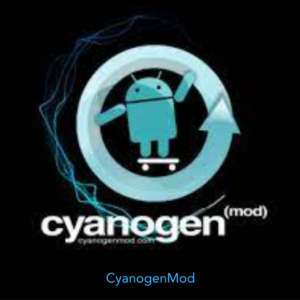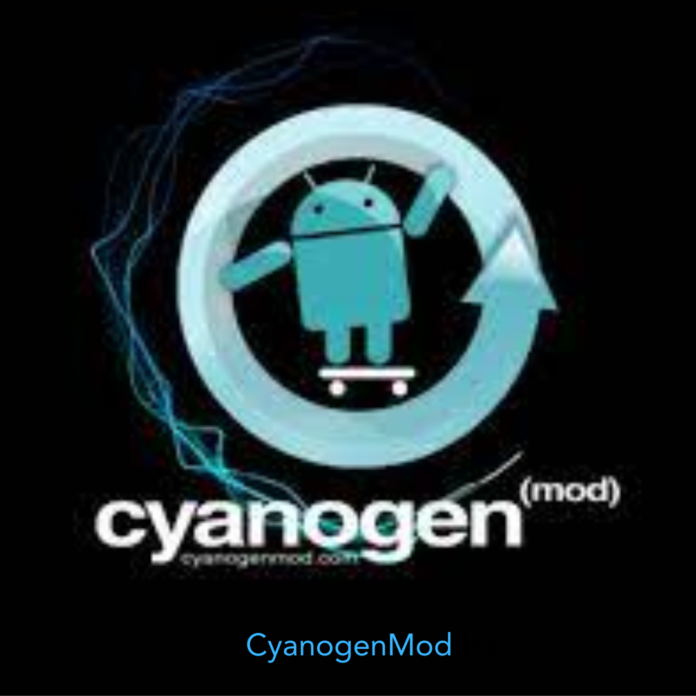CyanogenMod
CyanogenMod usually abbreviated to CM, is an open-source operating system for smartphones and tablet computers, based on the Android mobile platform. It is developed as free and open source software based on the official releases of Android by Google, with added original and third-party code. It is based on a rolling-release development model.
CyanogenMod offers features and options not found in the official firmware distributed by mobile device vendors. Features supported by CyanogenMod include native theming support,FLAC audio codec support, a large Access Point Name list, an OpenVPN client, Privacy Guard (per-application permission management application), support for tethering over common interfaces, CPU overclocking and other performance enhancements, unlockable bootloader and root access, soft buttons and other “tablet tweaks”, toggles in the notification pull-down (such as Wi-Fi, Bluetooth and GPS), and other interface enhancements. CyanogenMod does not contain spyware or bloatware, according to its developers. CyanogenMod is also said to increase performance and reliability compared with official firmware releases.
Although only a subset of total CyanogenMod users elects to report their use of the firmware, as of March 23, 2015, some reports indicate that over 50 million people run CyanogenMod on their phones.
In 2013, project founder Steve Kondik announced that venture funding had been obtained to establish Cyanogen Inc. as a commercial enterprise to develop and market the firmware more widely. This announcement has led to controversy within the community, with some developers asserting that rights and licensing issues, acknowledging/compensating past developers and honoring the original ethos of the community project, are not being adequately addressed.These claims were rejected by Kondik, who affirmed support for the community and stated that most CyanogenMod code, as with Android generally, is bound by a non-restrictive Apache license.

History and development
Soon after the introduction of the HTC Dream (named the “T-Mobile G1” in the United States) mobile phone in September 2008, a method was discovered to attain privileged control (termed “root access”) within Android’s Linux-based subsystem.[14] Having root access, combined with the open-source nature of the Android operating system, allowed the phone’s stock firmware to be modified and re-installed onto the phone.
In the following year, modified firmware for the Dream was developed and distributed by Android enthusiasts. One maintained by a developer named JessFreke, became popular among Dream owners. In August 2009, JessFreke stopped work on his firmware, and suggested users switch to a version of his ROM that had been further enhanced by developer Cyanogen (Steve Kondik) called “CyanogenMod”.
CyanogenMod grew in popularity, and a community of developers called the CyanogenMod Team (and informally “Team Douche”) made contributions. Within a few months, the number of devices and features supported by CyanogenMod blossomed, and CyanogenMod became one of the popular Android firmware distributions.
Similar to many open-source projects, CyanogenMod is developed using a distributed revision control system with the official repositories being hosted on GitHub. Contributors submit new features or bugfix changes using Gerrit.Contributions may be tested by anyone, voted up or down by registered users, and ultimately accepted into the code by one of a handful of CyanogenMod developers.
A version of ADW.Launcher, an alternative launcher (home screen) for the Android operating system, became the default launcher on CyanogenMod 5.0.8. The launcher provides additional features not provided by the default Android launcher, including more customization abilities (including icon themes, effects, and behavior), the ability to backup and restores configuration settings, and other features.As of version 9, CyanogenMod’s own launcher, Trebuchet, is included with the firmware.
Initially, CyanogenMod releases were provided on a nightly, milestone, and “stable version” schedule; as of CyanogenMod 11 M6, the “stable” label will no longer be used, having been supplanted by “milestone” M-builds that are part of the CyanogenMod’s rolling release development model.
Current CyanogenMod version list:
CyanogenMod 3 (Based on Android “Cupcake” 1.5.x, initial release)
CyanogenMod 4 (Based on Android “Cupcake” and “Donut” 1.5.x and 1.6.x)
CyanogenMod 5 (Based on Android “Eclair” 2.0/2.1)
CyanogenMod 6 (Based on Android “Froyo” 2.2.x)
CyanogenMod 7 (Based on Android “Gingerbread” 2.3.x)
CyanogenMod 9 (Based on Android “Ice Cream Sandwich” 4.0.x, major UI revamp)
CyanogenMod 10 (Based on Android “Jelly Bean” 4.1.x – 4.3.x)
CyanogenMod 11 (Based on Android “KitKat” 4.4.x)
CyanogenMod 12 (Based on Android “Lollipop” 5.0.x – 5.1.x, major UI revamp)
CyanogenMod 13 (Based on Android “Marshmallow” 6.0.x)(Under development)
CyanogenMod 7
CyanogenMod 7 firmware is based on Android 2.3 Gingerbread with additional custom code contributed by the CyanogenMod Team. The custom portions of CyanogenMod are primarily written by Cyanogen (Steve Kondik) but include contributions from the Xda-developers community (such as an improved launcher tray, dialer, and browser) and code from established open source projects (such as BusyBox in the shell).
CyanogenMod 7 development began when Google released Android 2.3’s source code.On 15 February 2011, the first release candidates of CyanogenMod 7 were rolled out on several of the supported devices.The fourth release candidate was released on 30 March 2011 and brought increased support for the Nook Color and similar devices as well as many bug fixes.On 11 April 2011, the public version of CyanogenMod 7.0 was released, based on Android 2.3.3.CyanogenMod 7.1 was released on 10 October 2011, based on Android 2.3.4.The latest stable version, CyanogenMod 7.2 was released on 16 June 2012, based on Android 2.3.7, bringing a predictive phone dialer, lock screen updates, ICS animation backports and many bug fixes.
CyanogenMod 8
CyanogenMod version 8 was planned to be based on Android 3.x Honeycomb. However, as the source code for Honeycomb wasn’t provided by Google until it appeared in the source tree history of its successor, Android 4.0 Ice Cream Sandwich, the release schedule advanced from CyanogenMod 7 (Gingerbread) directly to CyanogenMod 9 (Ice Cream Sandwich).
CM 9 is based on Google’s Android 4.0 Ice Cream Sandwich and the first version of CyanogenMod to use the Trebuchet launcher. Steve Kondik and his team have announced that they had begun work on the new release after Google released the source code of Android 4.0.1. Development on this release took longer than with previous releases due to the significance of the changes between Android 2.3 “Gingerbread” and 4.0 “Ice Cream Sandwich”, and the team took this opportunity to clarify their vision for the ROM and rethink any modifications which were no longer necessary due to improvements within Android.
By the last days of November 2011, some alpha versions had been distributed, in particular for the Samsung mobile phones Nexus S and Galaxy S. On 9 August 2012, after various betas and release candidates, CyanogenMod released the finished version of CyanogenMod 9. Given that the next version of Android, 4.1 “Jelly Bean”, had already been released by that point, development moved swiftly on to CyanogenMod 10. On 29 August 2012, CyanogenMod released a minor update, version 9.1.0, bringing bugfixes and an app called SimplyTapp for NFC payments.
On 4 April 2012, during development, CyanogenMod unveiled “Cid” (pronounced /sɪd/), the new CyanogenMod mascot, which replaced the previous mascot, Andy the skateboarding “bug droid”.[37] Designed by user Ciao, Cid (C.I.D.) is an abbreviation of “Cyanogenmod ID”.
CM 10
CM10.0
In early July 2012, the CyanogenMod team announced, via its Google+ account, that CyanogenMod 10 would be based on Android 4.1 Jelly Bean.Nightly builds of CyanogenMod 10 were made available for many devices supported by CyanogenMod 9.Starting with the September 2012 M1 build, the CyanogenMod team began monthly “M-series” releases. At the beginning of each month, a soft freeze of the CyanogenMod codebase is put into effect; once the team deems a build stable enough for daily use, it is released under the milestone or “M” series.
On 13 November 2012, final stable builds were released for several devices.
CM 10.1
CyanogenMod 10.1 is based on Android 4.2 Jelly Bean.Nightly versions are currently being released for an array of devices, along with M Snapshots (Monthly Snapshots) which are being released for select devices.
On 24 June 2013, the CyanogenMod 10.1.0 codebase (based on Android version 4.2.2) was moved to “stable” status, with a majority of currently-supported devices receiving stable builds on the same day.CyanogenMod’s developers have indicated that they will continue the Monthly Snapshot schedule to incorporate new features until the next CyanogenMod release. Unfortunately, many devices utilizing Samsung Exynos and Nvidia Tegra 2 SoC’s were not part of the initial release.
CM 10.2
The first nightly release of CyanogenMod 10.2, which is based on Android 4.3 Jelly Bean, began rolling out for a selected number of devices on 14 August 2013.It brings in some new enhancements to the system, such as Bluetooth Low Energy and OpenGL ES 3.0 support, a renewed Phone app, 4K resolution support as well as many security and stability improvements.
CM 11
On 6 November 2013, the CyanogenMod team started pushing the code of CyanogenMod 11, based on Android 4.4 KitKat, to GitHub.The first nightly release of CyanogenMod 11.0 began rolling out for a selected number of devices on 5 December 2013.[48] Since then, M-builds have been released every month for supported devices, offering a more stable experience than nightlies. With build M6 it was clarified that CyanogenMod would no longer be releasing final builds specially tagged “stable”, but instead, would utilize the rolling release model with M-builds representing a stable channel.
The global OnePlus One is shipped with a variant of CyanogenMod 11 M9 known as “CyanogenMod 11S”. The latest version of CyanogenMod 11S for the One is 11.0-XNPH05Q, based on CyanogenMod 11 M11 and Android 4.4.4 “KitKat”, and was released as an over-the-air (OTA) update in February 2015.
CM 12
The first nightly release of CyanogenMod 12, based on Android 5.0 Lollipop, began rolling out for a selected number of devices on 6 January 2015. A stable snapshot was released on 25 June 2015 and a security patch snapshot was released on 1 September 2015.
Cyanogen OS 12, a variant of CyanogenMod 12 for the OnePlus One and Yu Yureka was released in April 2015. Yu Yuphoria got Cyanogen OS 12 out-of-the-box when it was launched in May 2015.
CM 12.1
The first nightly release of CyanogenMod 12.1, based on Android 5.1, was announced on 16 April 2015.A stable snapshot build was released on 1 September 2015 but nightly builds continue to roll out every day.
Lenovo ZUK Z1, Wily fox Swift, and Storm got Cyanogen OS 12.1 out-of-the-box when it was launched in September 2015.YU’s Yureka and Yureka Plus got a Cyanogen OS 12.1 OTA update.android lollipop v5.1.1
CM 13
The first nightly release of CyanogenMod 13.0, based on Android 6.0, was released on 23 November 2015 for a small number of devices but was gradually developed for other devices.
A few weeks later, CyanogenMod was given a minor update and was based on Android 6.0.1.
For Latest Updates From Cyanogen Visit: Cyanogen Website

